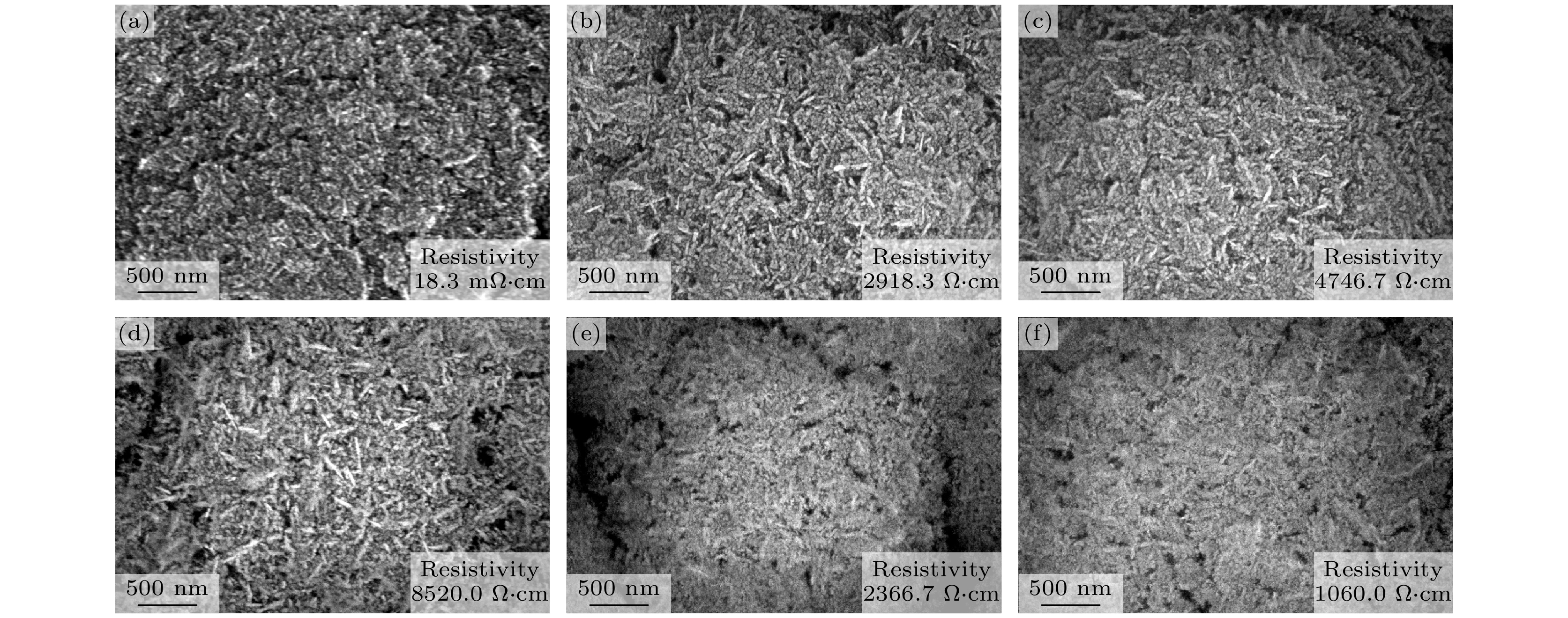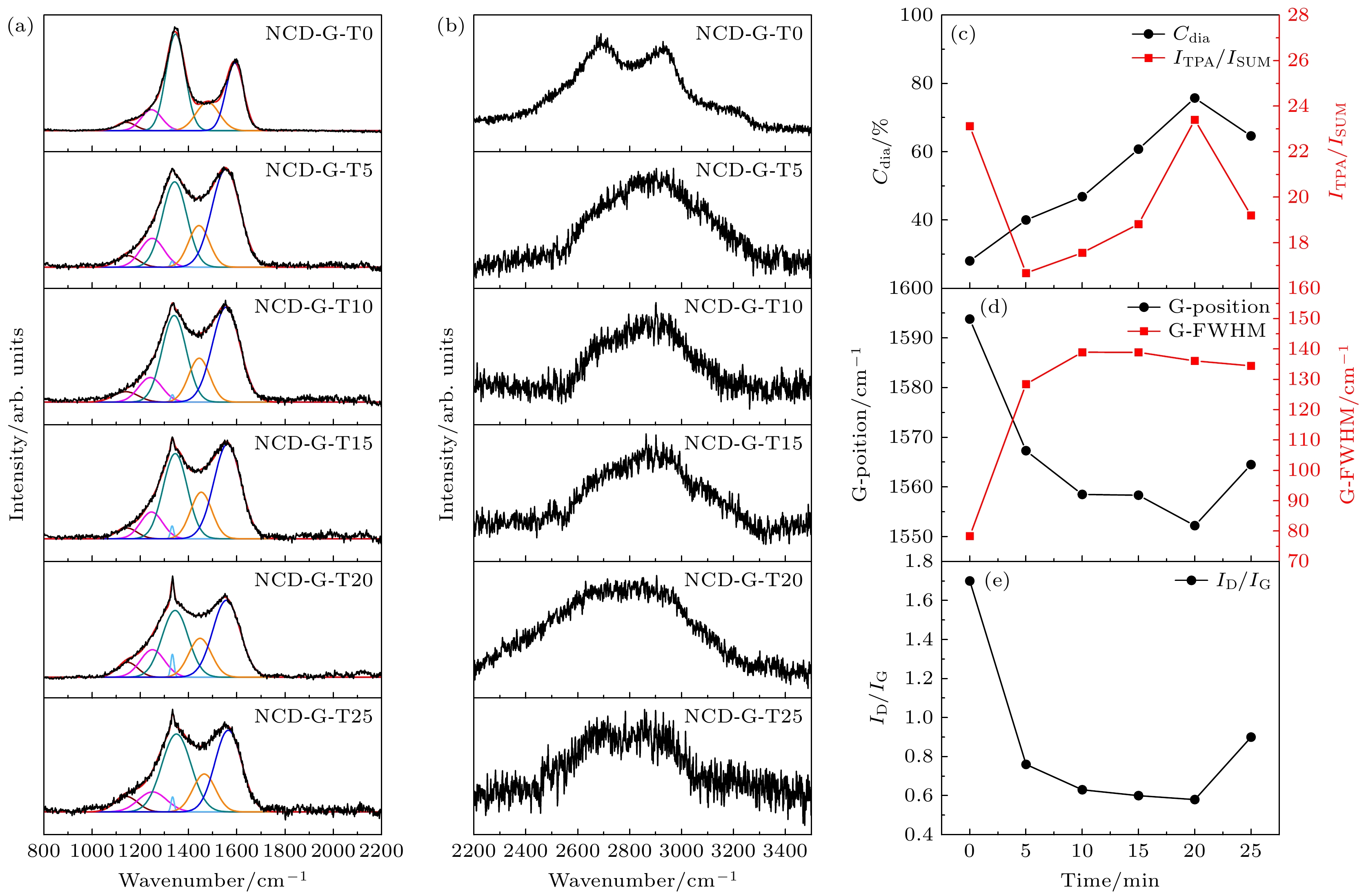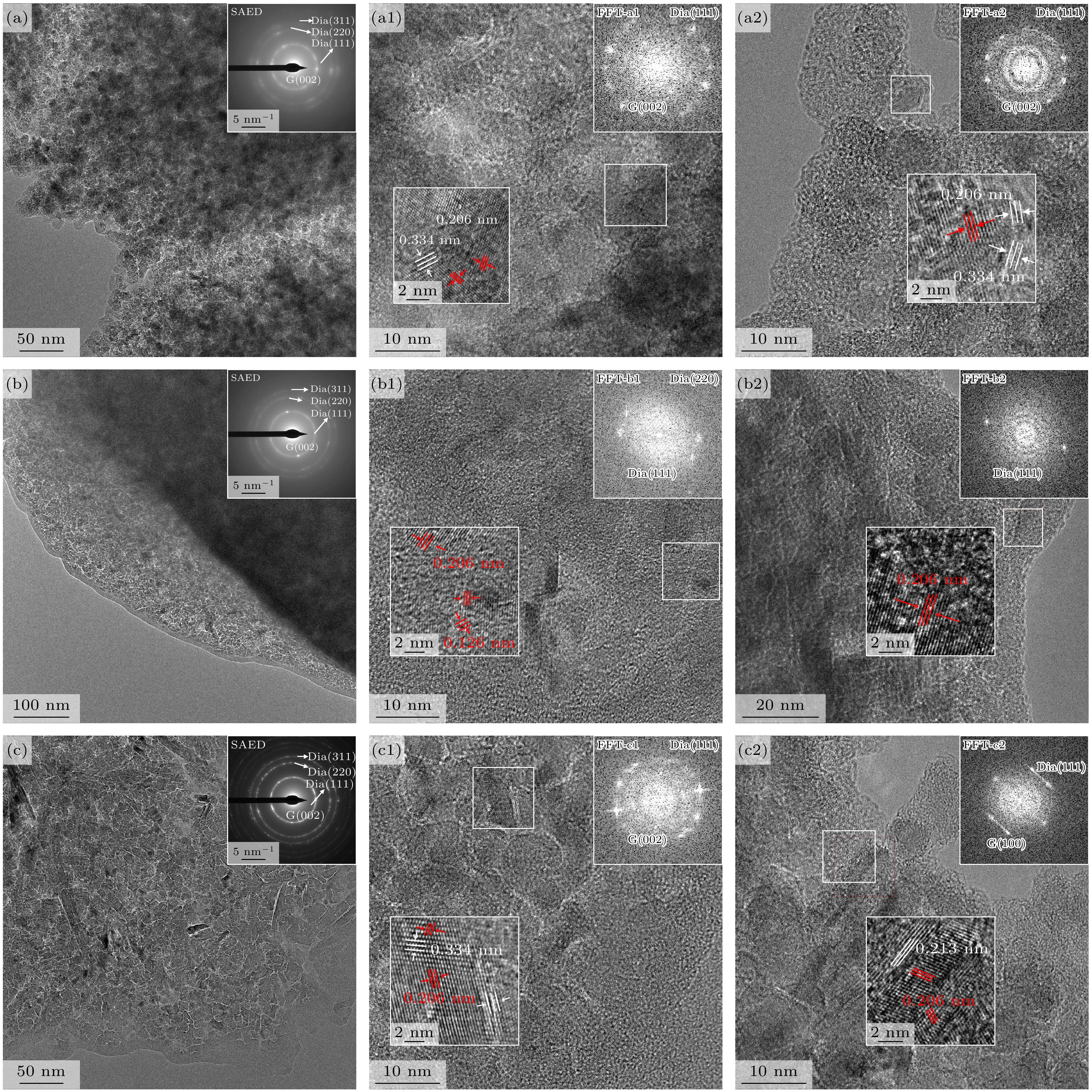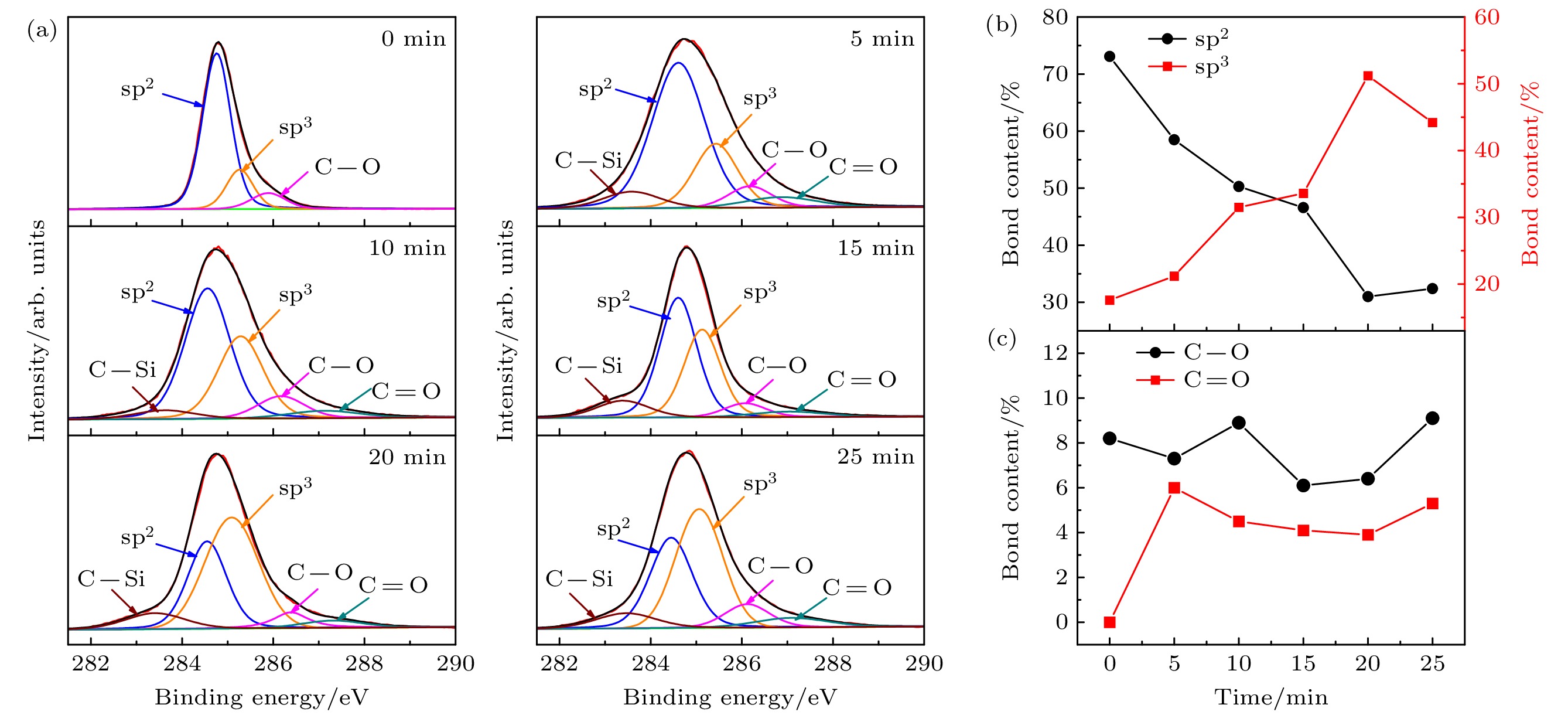-
金刚石/石墨烯复合薄膜电极因能发挥金刚石的低背景电流和宽电势窗口, 且兼具石墨烯的高电化学活性, 引起了人们的广泛关注. 本文采用氩/氧等离子体对纳米金刚石/石墨复合薄膜进行刻蚀, 通过改变刻蚀时间调控薄膜表面的石墨层数, 获得少层石墨烯包覆纳米金刚石的表面结构, 进而构建少层石墨烯包覆纳米金刚石的表层和石墨组分较多的导电性良好的底层, 形成双层结构. 结果表明, 氩/氧等离子体处理时间达到5 min时, 薄膜表层石墨组分被刻蚀成少层石墨包覆纳米金刚石的结构, 增大了电阻率(2918.3 Ω·cm)及电势窗口(3.43 V); 并且表面态由氢终止转变成氧终止, 使金刚石晶粒具有正电子亲和势, 电化学活性面积从387 μC/cm2增加到2893 μC/cm2. 随着处理时间继续延长至20 min时, 薄膜表面的石墨层数不断减少, 裸露的金刚石相含量增多, 薄膜的电阻率增加, 电化学活性面积减少; 当刻蚀时间达到25 min时, 复合薄膜下层石墨层暴露, 金刚石表面的石墨转变为少层石墨烯, 形成少层石墨烯包覆金刚石的顶层和石墨底层的双层结构, 使得电化学活性再次提升(775 μC/cm2), 并降低了复合薄膜的电阻率(1060.0 Ω·cm)并拓宽电势窗口(3.50 V). 本研究提供了一种等离子体刻蚀制备纳米金刚石/石墨烯复合电极的新方法, 为充分发挥金刚石/石墨烯的协同效应提供了新思路.
-
关键词:
- 金刚石/石墨烯复合薄膜 /
- Ar/O等离子体刻蚀 /
- 电化学性能
The diamond/graphene composite electrode has garnered significant attention due to its ability to synergistically combine the low background current and broad potential window of the diamond component with the high electrochemical activity of the graphitic component. In this study, argon-oxygen plasma etching is employed to treat nanodiamond/graphite composite films, and the surface structure of the few-layer graphene-coated nanodiamond is obtained by adjusting the etching time to control the number of graphite layers on the surface of the film, and then the surface layer of the few-layer graphene-coated nanodiamond and the bottom layer with good conductivity with more graphite components are constructed to form a double-layer structure. The experimental findings demonstrate that when the argon/oxygen plasma treatment time reaches 5 min, the graphite components on the surface layer of the film are etched into a structure of small-layer graphite coated nanodiamond, which increases the resistivity (2918.3 Ω·cm) and potential window (3.43 V). In addition, the surface state is changed from hydrogen termination to oxygen termination, so that the diamond grain has a positron affinity potential, and the electrochemical active area increases from 387 to 2893 μC/cm2. As the treatment time continues to extend to 20 min, the number of graphite layers on the surface of the film decreases, the diamond phase content increases, the resistivity of the film increases, and the electrochemically active area decreases. When the etching time reaches 25 min, the graphite layer under the composite film is exposed, and the graphite on the surface of the diamond is transformed into few-layer graphene, forming a double-layer structure of the top layer of few-layer graphene-coated diamond and the bottom layer of graphite, which synergistically improves the electrochemical activity (775 μC/cm2), reduces the resistivity of the composite film (1060.0 Ω·cm) and broadens the potential window (3.50 V). This work provides a novel plasma-etching strategy for fabricating diamond/graphene hybrid electrodes, and new insights into using the complementary advantages of these carbon allotropes for advanced electrochemical applications.[1] Kunuku S, Sankaran K J, Tsai C Y, Chang W H, Tai N H, Leou K C, Lin I N 2013 ACS Appl. Mater. Interfaces 5 7439
 Google Scholar
Google Scholar
[2] Cao Y, Legrain D R, Bigorda O R, Park J M, Watanabe K, Taniguchi T, Herrero P J 2020 Nature 583 215
 Google Scholar
Google Scholar
[3] Jiang M Y, Zhang Z Q, Chen C K, Ma W C, Han S J, Li X, Lu S H, Hu X J 2020 Carbon 168 536
 Google Scholar
Google Scholar
[4] Jiang M Y, Ma W C, Han S J, Chen C K, Fan D, Li X, Hu X J 2020 J. Appl. Phys. 127 015301
 Google Scholar
Google Scholar
[5] Lucio A J, Meyler R E P, Edwards M A, Macpherson J V 2020 ACS Sens. 5 789
 Google Scholar
Google Scholar
[6] Németh P, McColl K, Smith R L, Murri M, GarvieL A J, Alvaro M, Pécz B, Jones A P, Corà F, Salzmann C G, McMillan P F 2020 Nano Lett. 20 3611
 Google Scholar
Google Scholar
[7] Pei J X, Yu X, Zhang Z Q, Zhang J, Wei S B, Boukherroub R 2020 Appl. Surf. Sci. 527 146761
 Google Scholar
Google Scholar
[8] Shi D, Huang N, Liu L S, Yang B, Zhai Z F, Wang Y B, Yuan Z Y, Li H, Gai Z G, Jiang X 2020 Appl. Surf. Sci. 512 145652
 Google Scholar
Google Scholar
[9] Xu J, Yokota Y, Wong R A, Kim Y, Einaga Y 2020 J. Am. Chem. Soc. 142 2310
 Google Scholar
Google Scholar
[10] Arenal R, Bruno P, Miller D J, Bleuel M, Lal J, Gruen D M 2007 Phys. Rev. B 75 195431
 Google Scholar
Google Scholar
[11] Sankaran K J, Kurian J, Chen H C, Dong C L, Lee C Y, Tai N H, Lin I N 2012 J. Phys. D: Appl. Phys. 45 365303
 Google Scholar
Google Scholar
[12] Shang N, Papakonstantinou P, Wang P, Zakharov A, Palnitkar U, Lin I N, Chu M, Stamboulis A 2009 ACS Nano 3 1032
 Google Scholar
Google Scholar
[13] Shalini J, Sankaran K J, Dong C L, Lee C Y, Tai N H, Lin I N 2013 Nanoscale 5 1159
 Google Scholar
Google Scholar
[14] Shalini J, Lin Y C, Chang T H, Sankaran K J, Chen H C, Lin I N, Lee C Y, Tai N H 2013 Electrochim. Acta 92 9
 Google Scholar
Google Scholar
[15] Yuan Q L, Liu Y, Ye C, Sun H Y, Dai D, Wei Q P, Lai G S, Wu T Z, Yu A M, Fu L, Chee K W A, Lin C T 2018 Biosens. Bioelectron. 111 117
 Google Scholar
Google Scholar
[16] 蒋梅燕, 王平, 陈爱盛, 陈成克, 李晓, 鲁少华, 胡晓君 2022 物理学报 71 198101
 Google Scholar
Google Scholar
Jiang M Y, Wang P, Chen A S, Chen C K, Li X, Lu S H, Hu X J 2022 Acta Phys. Sin. 71 198101
 Google Scholar
Google Scholar
[17] 邢丽丹, 谢启明, 李伟善 2020 物理学报 69 228205
 Google Scholar
Google Scholar
Xing L D, Xie Q M, Li W S 2020 Acta Phys. Sin. 69 228205
 Google Scholar
Google Scholar
[18] Wang P, Yuan X X, Cui Z, Xu C Y, Sun Z L, Li J H, Liu J S, Tian Y, Li H D 2021 ACS Omega 6 6326
 Google Scholar
Google Scholar
[19] Cançado L G, Jorio A, Ferreira E H M, Stavale F, Achete C A, Capaz R B, Moutinho M V O, Lombardo A, Kulmala T S, Ferrari A C 2011 Nano Lett. 11 3190
 Google Scholar
Google Scholar
[20] Zhang X Y, Wang Y B, Gai Z G, Zhang M, Liu S S, Guo F X, Yang N J, Jiang X 2022 Carbon 196 602
 Google Scholar
Google Scholar
[21] Tully J J, Braxton E, Cobb S J, Breeze B G, Markham M, Newton M E, Rodriguez P, Macpherson J V 2021 Carbon 185 717
 Google Scholar
Google Scholar
[22] Lu Z G, Huang N, Zhai Z F, Chen B, Liu L S, Song H Z, Yuan Z Y, Zhang C Y, Yang B, Jiang X 2022 J. Mater. Sci. Technol. 105 26
 Google Scholar
Google Scholar
[23] Liu F M, Deng Z J, Miao D T, Chen W P, Wang Y J, Zhou K C, Ma L, Wei Q P 2021 J. Environ. Chem. Eng. 9 106369
 Google Scholar
Google Scholar
[24] Wang P, Wang T Y, Yang M C, Wang Q L, Yuan X X, Cui Z, Gao N, Liu J S, Cheng S H, Jiang Z G, Jin H C, Li H D 2024 Small 20 2402481
 Google Scholar
Google Scholar
-
图 2 氩/氧等离子体处理不同时间后NCD-G薄膜电极在不同溶液中的循环伏安i-E曲线 (a) 1 mol/L KCl溶液; (b) 0.001 mol/L [Fe(CN)6]3–/4–和1 mol/L KCl溶液
Fig. 2. Cyclic voltammetry i-E curves of NCD-G thin film electrode in different solutions after argon/oxygen plasma treatment for different time: (a) 1 mol/L KCl solution; (b) 0.001 mol/L [Fe(CN)6]3–/4– and 1 mol/L KCl solutions.
图 3 (a) NCD-G薄膜在800—2200 cm–1范围的可见光Raman光谱及其拟合结果; (b) 2200—3500 cm–1范围Raman谱图; (c)—(e) 800-2200 cm–1可见光Raman光谱拟合后部分典型参数随着氩/氧混合等离子体处理时间的变化图
Fig. 3. (a) Visible Raman spectra of NCD-G thin films in the range of 800–2200 cm–1 and their fitting results; (b) Raman spectra in the range of 2200–3500 cm–1; (c)–(e) some typical parameters of 800–2200 cm–1 visible Raman spectra with the treatment time of argon/oxygen mixed plasma.
表 1 氩/氧等离子体处理不同时间后NCD-G薄膜电极在1 mol/L KCl及0.001 mol/L Fe(CN)6]3–/4–溶液中的电化学性能参数
Table 1. Electrochemical performance parameters of NCD-G thin film electrodes in 1 mol/L KCl and 0.001 mol/L [Fe(CN)6]3–/4– solution after argon/oxygen plasma treatment for different time.
Sample Potential window/V Background
current/(mA·cm–2)Peak potential
difference ∆Ep/VElectrochemically
active area /(μC·cm–2)NCD-G-T0 3.32 14.41 0.041 387 NCD-G-T5 3.43 18.52 0.061 2893 NCD-G-T10 3.46 1.66 0.111 1272 NCD-G-T15 3.53 5.14 0.112 811 NCD-G-T20 3.56 1.44 — 257 NCD-G-T25 3.50 10.24 0.075 775 -
[1] Kunuku S, Sankaran K J, Tsai C Y, Chang W H, Tai N H, Leou K C, Lin I N 2013 ACS Appl. Mater. Interfaces 5 7439
 Google Scholar
Google Scholar
[2] Cao Y, Legrain D R, Bigorda O R, Park J M, Watanabe K, Taniguchi T, Herrero P J 2020 Nature 583 215
 Google Scholar
Google Scholar
[3] Jiang M Y, Zhang Z Q, Chen C K, Ma W C, Han S J, Li X, Lu S H, Hu X J 2020 Carbon 168 536
 Google Scholar
Google Scholar
[4] Jiang M Y, Ma W C, Han S J, Chen C K, Fan D, Li X, Hu X J 2020 J. Appl. Phys. 127 015301
 Google Scholar
Google Scholar
[5] Lucio A J, Meyler R E P, Edwards M A, Macpherson J V 2020 ACS Sens. 5 789
 Google Scholar
Google Scholar
[6] Németh P, McColl K, Smith R L, Murri M, GarvieL A J, Alvaro M, Pécz B, Jones A P, Corà F, Salzmann C G, McMillan P F 2020 Nano Lett. 20 3611
 Google Scholar
Google Scholar
[7] Pei J X, Yu X, Zhang Z Q, Zhang J, Wei S B, Boukherroub R 2020 Appl. Surf. Sci. 527 146761
 Google Scholar
Google Scholar
[8] Shi D, Huang N, Liu L S, Yang B, Zhai Z F, Wang Y B, Yuan Z Y, Li H, Gai Z G, Jiang X 2020 Appl. Surf. Sci. 512 145652
 Google Scholar
Google Scholar
[9] Xu J, Yokota Y, Wong R A, Kim Y, Einaga Y 2020 J. Am. Chem. Soc. 142 2310
 Google Scholar
Google Scholar
[10] Arenal R, Bruno P, Miller D J, Bleuel M, Lal J, Gruen D M 2007 Phys. Rev. B 75 195431
 Google Scholar
Google Scholar
[11] Sankaran K J, Kurian J, Chen H C, Dong C L, Lee C Y, Tai N H, Lin I N 2012 J. Phys. D: Appl. Phys. 45 365303
 Google Scholar
Google Scholar
[12] Shang N, Papakonstantinou P, Wang P, Zakharov A, Palnitkar U, Lin I N, Chu M, Stamboulis A 2009 ACS Nano 3 1032
 Google Scholar
Google Scholar
[13] Shalini J, Sankaran K J, Dong C L, Lee C Y, Tai N H, Lin I N 2013 Nanoscale 5 1159
 Google Scholar
Google Scholar
[14] Shalini J, Lin Y C, Chang T H, Sankaran K J, Chen H C, Lin I N, Lee C Y, Tai N H 2013 Electrochim. Acta 92 9
 Google Scholar
Google Scholar
[15] Yuan Q L, Liu Y, Ye C, Sun H Y, Dai D, Wei Q P, Lai G S, Wu T Z, Yu A M, Fu L, Chee K W A, Lin C T 2018 Biosens. Bioelectron. 111 117
 Google Scholar
Google Scholar
[16] 蒋梅燕, 王平, 陈爱盛, 陈成克, 李晓, 鲁少华, 胡晓君 2022 物理学报 71 198101
 Google Scholar
Google Scholar
Jiang M Y, Wang P, Chen A S, Chen C K, Li X, Lu S H, Hu X J 2022 Acta Phys. Sin. 71 198101
 Google Scholar
Google Scholar
[17] 邢丽丹, 谢启明, 李伟善 2020 物理学报 69 228205
 Google Scholar
Google Scholar
Xing L D, Xie Q M, Li W S 2020 Acta Phys. Sin. 69 228205
 Google Scholar
Google Scholar
[18] Wang P, Yuan X X, Cui Z, Xu C Y, Sun Z L, Li J H, Liu J S, Tian Y, Li H D 2021 ACS Omega 6 6326
 Google Scholar
Google Scholar
[19] Cançado L G, Jorio A, Ferreira E H M, Stavale F, Achete C A, Capaz R B, Moutinho M V O, Lombardo A, Kulmala T S, Ferrari A C 2011 Nano Lett. 11 3190
 Google Scholar
Google Scholar
[20] Zhang X Y, Wang Y B, Gai Z G, Zhang M, Liu S S, Guo F X, Yang N J, Jiang X 2022 Carbon 196 602
 Google Scholar
Google Scholar
[21] Tully J J, Braxton E, Cobb S J, Breeze B G, Markham M, Newton M E, Rodriguez P, Macpherson J V 2021 Carbon 185 717
 Google Scholar
Google Scholar
[22] Lu Z G, Huang N, Zhai Z F, Chen B, Liu L S, Song H Z, Yuan Z Y, Zhang C Y, Yang B, Jiang X 2022 J. Mater. Sci. Technol. 105 26
 Google Scholar
Google Scholar
[23] Liu F M, Deng Z J, Miao D T, Chen W P, Wang Y J, Zhou K C, Ma L, Wei Q P 2021 J. Environ. Chem. Eng. 9 106369
 Google Scholar
Google Scholar
[24] Wang P, Wang T Y, Yang M C, Wang Q L, Yuan X X, Cui Z, Gao N, Liu J S, Cheng S H, Jiang Z G, Jin H C, Li H D 2024 Small 20 2402481
 Google Scholar
Google Scholar
计量
- 文章访问数: 4112
- PDF下载量: 48
- 被引次数: 0














 下载:
下载:




